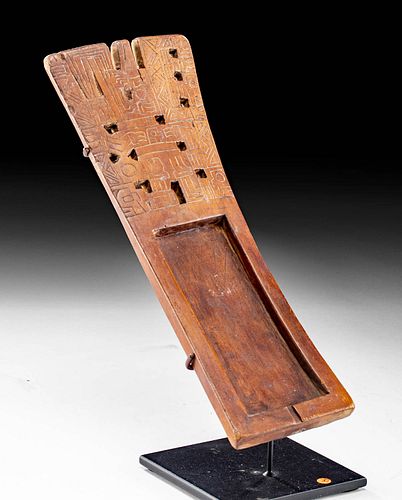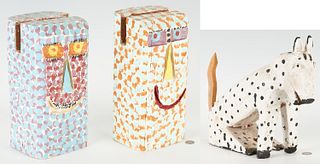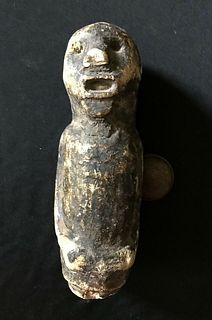Tiahuanaco Wood Snuff Tray (Rapero)
Lot 88
About Seller
Artemis Gallery
686 S Taylor Ave, Ste 106
Louisville, CO 80027
United States
Selling antiquities, ancient and ethnographic art online since 1993, Artemis Gallery specializes in Classical Antiquities (Egyptian, Greek, Roman, Near Eastern), Asian, Pre-Columbian, African / Tribal / Oceanographic art. Our extensive inventory includes pottery, stone, metal, wood, glass and textil...Read more
Estimate:
$2,400 - $3,600
Absentee vs Live bid
Two ways to bid:
- Leave a max absentee bid and the platform will bid on your behalf up to your maximum bid during the live auction.
- Bid live during the auction and your bids will be submitted real-time to the auctioneer.
Bid Increments
| Price | Bid Increment |
|---|---|
| $0 | $25 |
| $300 | $50 |
| $1,000 | $100 |
| $2,000 | $250 |
| $5,000 | $500 |
| $10,000 | $1,000 |
| $20,000 | $2,500 |
| $50,000 | $5,000 |
| $100,000 | $10,000 |
| $200,000 | $20,000 |
About Auction
By Artemis Gallery
Apr 8, 2021
Set Reminder
2021-04-08 10:00:00
2021-04-08 10:00:00
America/New_York
Bidsquare
Bidsquare : Fine Antiquities | Asian | Ethnographic Art
https://www.bidsquare.com/auctions/artemis-gallery/fine-antiquities-asian-ethnographic-art-6770
Features classical antiquities, ancient and ethnographic art from cultures encompassing the globe. Egyptian, Greek, Roman, Etruscan, Near Eastern, Asian, Pre-Columbian, Native American, African / Tribal, Oceanic, Spanish Colonial, Russian, Fine Art, so much more! All legally acquired, legal to sell. Artemis Gallery info@artemisgallery.com
Features classical antiquities, ancient and ethnographic art from cultures encompassing the globe. Egyptian, Greek, Roman, Etruscan, Near Eastern, Asian, Pre-Columbian, Native American, African / Tribal, Oceanic, Spanish Colonial, Russian, Fine Art, so much more! All legally acquired, legal to sell. Artemis Gallery info@artemisgallery.com
- Lot Description
Pre-Columbian, Chile, San Pedro, Atacama Desert, Tiahuanaco / Tiwanaku, ca. 400 to 700 CE. A fabulous hand-carved wooden snuff tray, known as a rapero, of a rectangular form with a recessed quadrilateral for holding and preparing hallucinogenic substances used in rituals. The top of the fascinating vessel is intricately incised with an abstract rendering of a figure holding a staff, decorated with and surrounded by geometric motifs, as well as a series of decorative rectangular and triangular apertures. Size: 8.5" L x 3.125" W (21.6 cm x 7.9 cm); 7.5" H (19 cm) on included custom stand.
According to the Metropolitan Museum of Art, "Snuff inhaled through tubes from small trays or tablets was common in the southern Andes where hallucinogen use was widespread… In the Atacama region of northern Chile, the highest concentration of wooden snuff trays has been found in burials in association with other paraphernalia, such as inhaling tubes, spatulas, small mortars and pestles, and snuff powder containers. The snuff, prepared from leaves, resin, and seeds of various plants dried and finely ground, was used to cure various ailments, to alleviate pain and conditions associated with high altitudes, to provide alertness in war and hunting, and to induce trances during rituals and ceremonies."
Provenance: private Hawaii, USA collection; ex-private Hans Juergen Westermann collection, Germany, acquired from 1950 to 1960s
All items legal to buy/sell under U.S. Statute covering cultural patrimony Code 2600, CHAPTER 14, and are guaranteed to be as described or your money back.
A Certificate of Authenticity will accompany all winning bids.
We ship worldwide and handle all shipping in-house for your convenience.
#162990Verso has staining to corner and minor stable fissure to top. Expected nicks, scratches, and staining, commensurate with age and use. Otherwise, intact and excellent with nice patina and light earthen deposits in recessed areas.Condition
- Shipping Info
-
All shipping is handled in-house for your convenience. Your invoice from Artemis Gallery will include shipping calculation instructions. If in doubt, please inquire BEFORE bidding for estimated shipping costs for individual items.
-
- Buyer's Premium



 EUR
EUR CAD
CAD AUD
AUD GBP
GBP MXN
MXN HKD
HKD CNY
CNY MYR
MYR SEK
SEK SGD
SGD CHF
CHF THB
THB













